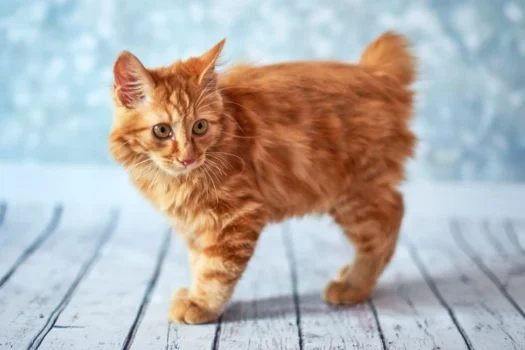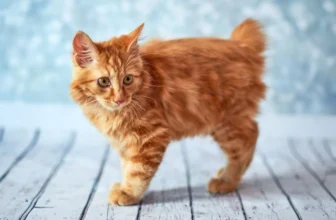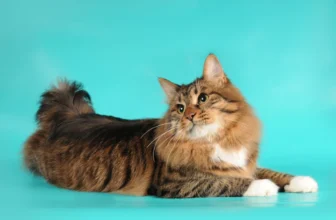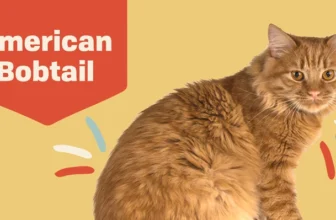Introduction
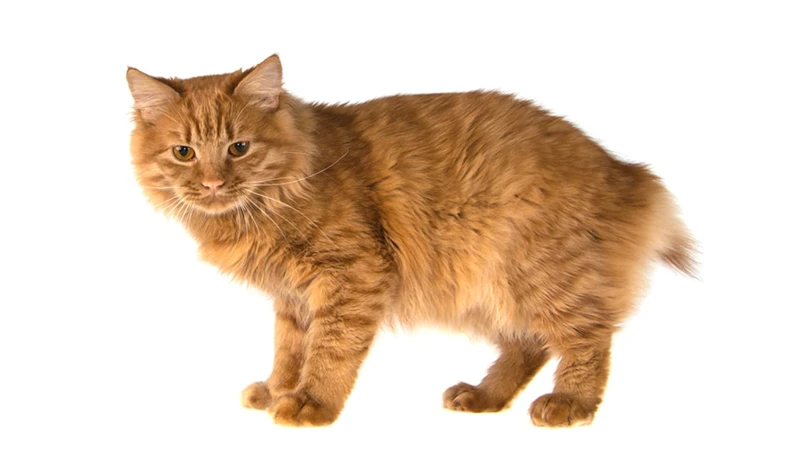
Welcoming a new American Bobtail into your home can be an exciting and enriching experience. This breed is known for its playful and affectionate nature, which can make them a great addition to any household. However, like all pets, American Bobtails can develop behavior issues that may need to be addressed. In this article, we will discuss the most common behavior problems that American Bobtails may exhibit and effective strategies for addressing and preventing these issues. Whether you are a seasoned pet owner or a first-time American Bobtail owner, understanding your furry friend’s behavior is essential for creating a happy and healthy home environment.
What are American Bobtails?
American Bobtails are a unique breed of cat with a distinctive short, bobbed tail. The breed was first developed in the late 1960s in the United States through the breeding of a short-tailed male cat with a wild bobcat. Since then, the breed has been recognized by several cat registries and is known for its intelligent and affectionate personality.
Physical Characteristics of American Bobtails
| Characteristic | Description |
|---|---|
| Size | Medium to Large |
| Weight | 7-16 pounds |
| Coat | Short or medium-length, thick and plush, with a slightly shaggy appearance. Comes in a variety of colors and patterns. |
| Tail | Short, usually 1/3 to 1/2 the length of a regular cat’s tail. Can be straight or curved, and may have kinks or bumps. |
| Body | Muscular and sturdy, with broad shoulders and hips. |
American Bobtails are known for their playful and sociable personalities, as well as their intelligence and adaptable nature. They are often compared to dogs in their loyalty and willingness to learn. To better understand your American Bobtail’s behavior and communication, it’s important to learn about their body language. You can find more information on this in our article “Understanding American Bobtail Cat Body Language”.
It’s also important to note that American Bobtails respond very well to reward-based training methods. This includes clicker training, which is a great way to teach your cat new skills and tricks. To learn more about clicker training and how to get started, check out our article on “Clicker Training for American Bobtails: Getting Started”.
Now that we have a basic understanding of American Bobtails, let’s dive into some common behavior problems they may exhibit and how to address them.
Understanding Common Behavior Problems in American Bobtails
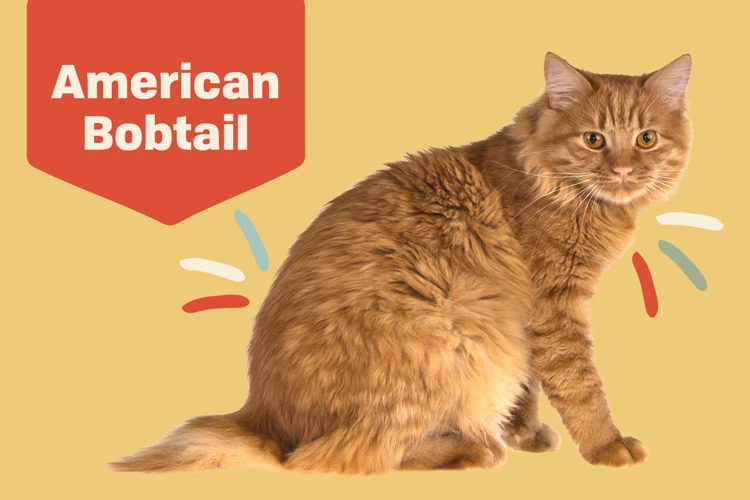
Understanding the behavior of American Bobtails is important for every cat owner. These felines are known for having unique and fun-loving personalities. However, like all cats, American Bobtails can develop certain behavior problems that can make it difficult to live with them. In this section, we will explore the most common behavior problems in American Bobtails and how to address them. Whether it is excessive meowing or aggressive behavior, we will provide valuable insights and tips to help you understand and modify your cat’s behavior. By knowing how to handle these behavior issues, you can ensure a happy and harmonious relationship with your American Bobtail.
Aggression
Aggression in American Bobtails is a common behavior problem that can cause distress for both the cat and their owner. This behavior can manifest in multiple ways, ranging from growling and hissing to biting and scratching. While some level of aggression can be normal in cats, excessive aggression can be a sign of an underlying issue that needs to be addressed.
Causes of Aggression:
– Fear: American Bobtails may become aggressive if they feel threatened or scared. This can be caused by unfamiliar people or surroundings, loud noises, or other stressful situations.
– Territoriality: American Bobtails are known to be territorial animals. They may become aggressive to defend their territory, especially if other cats or animals are present.
– Pain: Cats may become aggressive if they’re in pain. This could be due to a medical condition or injury.
– Predatory instincts: American Bobtails are natural hunters and may become aggressive when they see prey.
How to Address Aggression:
– Consult with a veterinarian: A veterinarian can help rule out any medical causes for the aggression.
– Identify triggers: Pay attention to what triggers the aggression in your cat. This can be helpful in avoiding those situations or finding a way to desensitize your cat to the trigger.
– Positive reinforcement: Rewarding good behavior with treats or praise can help reinforce positive behavior in American Bobtails. (Learn more about reward-based training.)
– Provide enough mental and physical stimulation: Providing toys and activities that stimulate your cat mentally and physically can help reduce aggression. For example, you can try taking your cat for a walk on a leash (learn more here).
– Behavior modification: If the aggression is severe, behavior modification may be necessary. This can involve working with a professional animal behaviorist to address the underlying issues.
It’s important to address aggression in American Bobtails as soon as possible to avoid any potential harm to yourself or others. If you’re raising American Bobtail kittens, early socialization can help prevent aggression issues from developing.
Keep in mind that addressing aggression in American Bobtails can be a slow and gradual process. Patience and consistency are key to ensuring your cat behaves in a way that’s safe and comfortable for everyone.
Excessive Meowing
Excessive meowing is another common behavior problem that American Bobtail owners may face. It can be quite frustrating for both the cat and its owners. Here are some reasons why American Bobtails may meow excessively and what can be done to address it:
Pain or discomfort: Excessive meowing can be a way for cats to communicate that they are in pain or discomfort. If your American Bobtail suddenly starts meowing excessively, it is important to take them to the vet to rule out any underlying health issues.
Hunger or Thirst: American Bobtails may also meow excessively when they are hungry or thirsty. Make sure to provide them with plenty of fresh water and food throughout the day. Creating a feeding schedule can also help prevent excessive meowing.
Boredom: American Bobtails are intelligent cats that require mental stimulation. If they don’t have enough things to do, they may start meowing excessively out of boredom. Providing your cat with interactive toys and playing with them regularly can help keep them entertained.
Separation Anxiety: Some American Bobtails may develop separation anxiety when their owners leave the house. Excessive meowing can be a sign of distress caused by separation anxiety. Training your cat to be more independent and gradually increasing the amount of time they spend alone can help reduce separation anxiety.
Attention-seeking: American Bobtails are highly social cats that crave attention. If they are not getting enough attention, they may start meowing excessively to get your attention. Make sure to give your cat enough attention throughout the day and play with them regularly.
To prevent excessive meowing in American Bobtails, it is important to establish a daily routine that includes regular playtime, feeding, and attention. Providing your cat with enough stimulation, both mentally and physically, can also help prevent boredom and attention-seeking behavior.
In case of excessive meowing, avoid yelling or punishing your American Bobtail. Instead, positively reinforce good behavior with treats and praise. You can also consider training your cat with basic commands to better communicate with them and reduce excessive meowing.
Learn more about training your American Bobtail with basic commands.
Destructive Scratching
Destructive scratching is another common behavior problem in American Bobtails, and it can be frustrating for owners who struggle to keep their furniture and belongings intact. This behavior is a natural instinct for cats and serves various purposes such as stretching and sharpening their claws, marking their territory, and even as a way to relieve stress and tension. However, it can become problematic when they begin to scratch furniture, carpets, and walls.
Understanding the Cause: One of the primary reasons for destructive scratching is boredom and lack of stimulation. It is crucial to provide your American Bobtail with enough physical and mental stimulation to prevent destructive behavior. Other reasons may include their need to mark their scent, anxiety, and fearfulness.
Addressing the Behavior: One of the most effective ways to prevent destructive scratching is by providing them with appropriate scratching options. A scratching post made of sisal rope or cardboard is ideal and should be placed in areas where they tend to scratch the most. Positive reinforcement, such as treats and praise, should be given when they use the scratching post instead of the furniture. Consistency is key, and you should discourage them from scratching the furniture by interrupting them with a loud noise or a clap of your hands.
Another way to address the behavior is by trimming their claws regularly. This not only prevents damage to furniture but also helps keep their claws healthy. If necessary, soft plastic caps can be placed over their claws to prevent damage to furniture.
Preventing the Behavior: Providing plenty of physical and mental stimulation is crucial in preventing destructive scratching. Playing with your American Bobtail regularly, providing toys, and even using puzzle feeders for their meals can keep their minds and bodies engaged.
Another way to prevent destructive scratching is by creating a safe and secure home environment. Minimizing loud noises and sudden movements can help reduce anxiety and prevent destructive behavior. It is also essential to provide them with their own space where they can relax and feel safe.
If destructive scratching persists despite preventative measures, it may be necessary to consult with a veterinarian or a professional animal behaviorist for additional guidance and training.
Conclusion: Destructive scratching is a common but frustrating behavior problem in American Bobtails. Understanding the cause, addressing the behavior, and preventing the behavior through proper care and environmental enrichment can help keep your furniture and your American Bobtail safe and happy.
Litter Box Issues
Litter box issues are a common problem for many cat breeds, and American Bobtails are no exception. If your American Bobtail is not using the litter box properly, it can lead to unpleasant odors and messes throughout your home. Common litter box problems can include avoidance of the litter box, urinating or defecating outside the box, and refusing to use a shared litter box with other cats. Here are a few reasons why your American Bobtail may be having litter box issues and how to address them:
- Unsatisfactory Litter Box Setup: Make sure you have an adequate number of litter boxes for the number of cats in your home. Additionally, litter boxes should be large enough for your cat to move around in comfortably, and the litter should be no less than three inches deep.
- Health Issues: If your American Bobtail is experiencing an underlying health issue, they may avoid their litter box. Urinary tract infections, bladder stones, or other medical problems can cause discomfort or pain, leading your cat to choose other places to relieve themselves.
- Anxiety or Stress: Cats may avoid the litter box if they are feeling anxious or stressed. If there have been any recent changes in your home, such as a new pet, move or schedule changes, your cat may feel uneasy. Providing a comfortable and secure environment, as well as reassurance and behavior modification, can help your cat feel more relaxed and reduce any anxiety associated with using the litter box.
- Litter Preferences: Some American Bobtails may have preferences for certain types of litter, including texture, scent, or color. Experimenting with different types of litter may help solve this issue.
If you notice any of these behaviors in your American Bobtail, you should have them examined by a veterinarian to ensure there are no underlying medical problems. If the problem is behavioral, try making changes to the litter box, litter type, or environment to help your cat feel more comfortable. Remember to use positive reinforcement when your American Bobtail does use the litter box appropriately, such as giving them treats or verbal praise. By addressing the underlying cause and providing a positive and secure environment, you can help prevent and resolve litter box problems in your American Bobtail.
Anxiety and Fearfulness
As with any other pets, American Bobtails can also develop anxiety and fearfulness. These are common behavior problems that can be triggered by different factors such as changes in routine, lack of socialization, or traumatic experiences. It’s important for pet owners to recognize the signs of anxiety and fearfulness in their American Bobtails and take action to address these problems before they lead to more serious issues.
Signs of Anxiety and Fearfulness in American Bobtails
Some common signs of anxiety and fearfulness in American Bobtails include excessive meowing, hiding or retreating from humans, excessive grooming, loss of appetite, diarrhea, and aggressive behavior towards other animals or humans.
Causes of Anxiety and Fearfulness in American Bobtails
There are various reasons why American Bobtails may develop anxiety and fearfulness. Some of these include:
| Causes of Anxiety and Fearfulness in American Bobtails | Description |
| Change in routine | American Bobtails are creatures of habit and any changes in their routine can lead to anxiety and fearfulness. For example, if the pet owner suddenly changes their work schedule or moves to a new house, the cat can become very anxious. |
| Traumatic events | A traumatic experience such as being attacked by another animal or being hit by a car can cause anxiety and fearfulness in American Bobtails. Even if the cat is physically fine, the emotional trauma can have long-lasting effects on their behavior. |
| Lack of socialization | American Bobtails that are not exposed to different types of people, animals or environments can become anxious and fearful when introduced to new situations. Early socialization is key to helping them feel comfortable in different settings. |
| Medical conditions | Chronic pain or illness can also cause anxiety and fearfulness in American Bobtails. It’s important to take them to the vet for regular check-ups to rule out any underlying medical issues. |
Addressing Anxiety and Fearfulness in American Bobtails
It’s important to address anxiety and fearfulness in American Bobtails as soon as possible. Here are some tips on how to help your pet:
- Comfort them: Provide a safe place for your American Bobtail to retreat to, such as a cozy cat bed, and give them lots of attention and affection.
- Reduce stress: Minimize stressors in their environment by keeping other pets away or providing quiet spaces in the house.
- Consult with a veterinarian: A veterinarian may prescribe anti-anxiety medication or other treatments to help your American Bobtail feel calm.
- Behavior modification: Slowly introduce your American Bobtail to new situations to help them acclimate and reduce their anxiety. Positive reinforcement, such as treats and toys, can help them associate new experiences with positive outcomes.
By taking the time to understand the causes of anxiety and fearfulness in your American Bobtail and addressing the problem through a combination of training, medical treatments, and environmental modifications, you can help your pet feel more comfortable and confident in their surroundings. This will ultimately lead to a happier, healthier life for both you and your furry friend.
If you’re new to American Bobtails, check out our introduction to American Bobtails.
Food-related Issues
One common behavior problem that American Bobtail owners may face is related to food. This can include overeating, begging for food excessively, or being picky eaters. It’s important to address these issues to ensure your feline friend is healthy and happy.
Overeating: If your American Bobtail is overeating, it can lead to obesity and other health issues. One way to address this is by feeding your cat smaller, more frequent meals throughout the day. You can also use puzzle feeders to slow down their eating and make it more stimulating.
Begging for food: If your American Bobtail is constantly begging for food and treats, it can be tempting to give in. However, it’s important to stick to a regular feeding schedule and avoid giving in to their demands. You can also try providing distraction or playtime to redirect their focus.
Picky eaters: Some American Bobtails may be picky eaters and refuse certain types of food. It’s important to choose a high-quality, balanced diet that meets their nutritional needs. If your cat still refuses to eat, you can try offering different types of food or mixing in wet food for added flavor and moisture.
It’s crucial to monitor your cat’s food intake and ensure they are maintaining a healthy weight. If you’re concerned about your American Bobtail’s eating habits, consult with your veterinarian for personalized advice and guidance.
Addressing Behavior Problems in American Bobtails
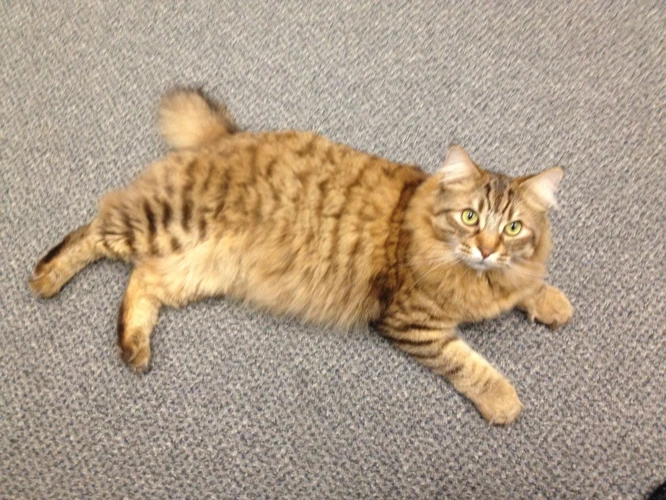
When it comes to dealing with behavior problems in American Bobtails, it’s important to address them as soon as possible. Ignoring these issues can lead to further problems down the line, and can cause stress and frustration for both you and your furry friend. Luckily, there are several effective strategies that can be used to address these common issues. By taking a proactive and compassionate approach, you can help your American Bobtail identify the underlying cause of their behavior and find solutions that work for both of you. Let’s explore some of these strategies in more detail below.
Understanding the Cause
To effectively address behavior problems in American Bobtails, it’s important to understand the underlying causes. The table below outlines the common behavior problems in American Bobtails and their potential causes:
| Behavior Problem | Potential Cause |
|---|---|
| Aggression | Lack of socialization, fear, territoriality, health issues |
| Excessive Meowing | Hunger, boredom, anxiety, attention-seeking, aging |
| Destructive Scratching | Boredom, anxiety, lack of appropriate scratching surfaces, stress |
| Litter Box Issues | Dirty litter box, medical issues, anxiety, territoriality |
| Anxiety and Fearfulness | Trauma, lack of socialization, fear, changes in environment |
| Food-related Issues | Poor nutrition, lack of appetite, overfeeding, health issues |
It’s important to note that these are not the only potential causes for each behavior problem, and some problems may have multiple underlying causes. Identifying the specific cause of the behavior problem is crucial in developing an effective plan to address it. By understanding the cause, we can tailor our approach to address the root of the problem and prevent it from reoccurring in the future.
Positive Reinforcement
Positive reinforcement is a powerful tool in addressing behavior problems in American Bobtails. This method of training involves rewarding your cat for good behavior, rather than punishing them for bad behavior. Using positive reinforcement can help your cat associate good behavior with positive outcomes and encourage them to repeat those behaviors. Here are some examples of positive reinforcement techniques you can use with your American Bobtail:
| Technique | Description |
|---|---|
| Clicker Training | This technique uses a clicker to signify when your cat has done something good. You can then reward your cat with a treat or praise. Over time, your cat will begin to associate the sound of the clicker with positive outcomes. |
| Treats | Using treats is a classic form of positive reinforcement. When your cat performs a desirable behavior, such as using the litter box, give them a treat. However, be sure to limit the number of treats you give your cat to avoid overfeeding. |
| Praise | Cats respond well to praise, especially if it’s accompanied by physical affection like petting or playing. When your cat shows good behavior, praise them for it, and give them some extra attention. |
It’s essential to be consistent with your positive reinforcement techniques. Over time, your cat will begin to understand which behaviors lead to positive outcomes and which ones don’t. Remember to use positive reinforcement in conjunction with other techniques, such as providing physical and mental stimulation and addressing underlying issues that may be causing bad behavior. By doing so, you can help your American Bobtail become a happy and well-behaved member of your family.
Physical and Mental Stimulation
Providing American Bobtails with both physical and mental stimulation is crucial in addressing behavior problems. These cats are highly intelligent and active, and without adequate stimulation, they may engage in destructive or aggressive behaviors.
Physical Stimulation: Exercise and play are important for keeping American Bobtails physically active and mentally engaged. Interactive toys, such as wand toys and laser pointers, can provide a great way to encourage play while also promoting exercise. It is also recommended to provide ample space for your cat to run and climb around the home. Installing a cat tree or scratching post can give your American Bobtail a designated area to climb and scratch, which can redirect their behavior from destructive scratching on furniture.
Mental Stimulation: American Bobtails are highly intelligent cats that require mental stimulation as well. Providing puzzles, such as treat puzzles or hiding toys or food, can be a great way to engage their minds. Teaching tricks or obedience training can also be a great way to engage with your cat and provide mental stimulation. Additionally, providing a variety of toys with different textures and sounds can keep your American Bobtail curious and mentally stimulated.
To summarize, American Bobtails require both physical and mental stimulation to stay happy and healthy. Providing interactive toys, space to run and climb, puzzles, and training can keep them engaged and help address behavior problems related to boredom or lack of stimulation. Incorporating physical and mental stimulation into your cat’s daily routine can make a huge difference in their overall well-being.
| Physical Stimulation | Mental Stimulation |
|---|---|
| Exercise and play | Treat puzzles or hiding toys/food |
| Interactive toys (wand toys, laser pointer) | Teaching tricks/obedience training |
| Provide space for running/climbing (cat tree/scratching post) | Offering toys with different textures/sounds |
Training and Behavior Modification
One effective way to address behavior problems in American Bobtails is through training and behavior modification. This involves teaching your cat new behaviors to replace undesirable ones, as well as correcting problematic actions.
Training and behavior modification can be especially useful for aggression, excessive meowing, destructive scratching, and litter box issues. For example, if your American Bobtail has a habit of scratching furniture, you can train them to use a scratching post instead.
Steps for Training and Behavior Modification
| Step | Description |
|---|---|
| 1 | Identify the problem behavior and determine the desired alternative behavior. |
| 2 | Set realistic goals and establish a training plan. |
| 3 | Use positive reinforcement, such as treats and praise, to encourage desired behaviors. |
| 4 | Be consistent with training and avoid punishing or scolding your cat for undesirable behaviors. |
| 5 | Gradually decrease the use of treats and praise as your cat learns the desired behaviors. |
| 6 | Monitor progress and make adjustments as needed. |
It’s important to note that training and behavior modification may take time and patience. It’s also important to avoid physical punishment or negative reinforcement, as this can damage your relationship with your American Bobtail and worsen behavior problems.
In addition to training and behavior modification, providing your American Bobtail with plenty of physical and mental stimulation can also help reduce behavior problems. This includes providing toys, scratching posts, and puzzles to keep your cat entertained and engaged.
By taking the time to train and modify behavior, you can help your American Bobtail become a well-behaved and happy member of your household.
Preventing Behavior Problems in American Bobtails
As a responsible cat owner, it’s important to take proactive measures to prevent behavior problems in your American Bobtail. By taking preventative measures, you can minimize the risk of your beloved feline companion developing unwanted behaviors that can cause stress and frustration for both you and your cat. From early socialization and establishing a routine to providing proper nutrition and a safe home environment, here are some effective ways to prevent behavior problems in your American Bobtail cat.
Early Socialization
Early socialization is crucial in preventing behavior problems in American Bobtails. It involves exposing your kitten to a wide variety of people, animals, and experiences during their early weeks of life. This helps your kitten develop a confident personality and prevents them from becoming fearful or aggressive towards new experiences later in life.
Here are some tips for early socialization:
- Introduce your kitten to a variety of people, including children and individuals with different ethnicities or physical appearances.
- Expose your kitten to different animals, such as dogs, cats, and small animals, under controlled conditions.
- Allow your kitten to explore different surfaces, textures, and sounds in a safe environment.
- Take your kitten for short car rides to help them get used to traveling in a vehicle.
It is important to remember that socialization should be done gradually and in a positive manner. You should always supervise your kitten and never force them into unfamiliar situations. If your kitten shows signs of fear or anxiety, take a step back and try again later. Early socialization is an investment in your kitten’s future behavior and happiness, so it should not be overlooked.
Establishing a Routine
Establishing a routine is an essential aspect when it comes to maintaining your American Bobtail’s health and well-being. Just like humans, felines thrive in a predictable environment that provides them with a sense of comfort and security. Establishing a routine involves creating a schedule and sticking to it as much as possible. Here are some important aspects to consider when creating a routine for your American Bobtail:
| Feeding Schedule | Exercise and Playtime | Sleep Schedule |
|---|---|---|
| Set up a daily routine for feeding your American Bobtail at the same time each day. This will help them understand when to expect their meals, which can reduce anxiety and stress. | Make sure to set aside time each day for exercise and playtime. This could include activities such as playing with toys, climbing on cat trees or scratching posts, and exploring their environment. | Establish a regular sleep schedule for your cat. Since cats sleep for most of the day, it’s important to create a comfortable sleeping environment for them, ideally in a quiet and dark area. |
| When feeding your American Bobtail, ensure you’re providing them with the appropriate amount of food and the right type of food to support their needs, such as protein-rich meals that help maintain their muscle mass. | Incorporate exercise and playtime into your routine, ensuring that your cat gets enough physical activity to support their mental and physical health. | Incorporate regular nap times into your cat’s routine, allowing them to recharge and rest as needed. |
| Try to keep a consistent feeding schedule to keep your American Bobtail in good health and reduce the likelihood of overeating. | Be sure to switch up the toys and activities you provide your cat daily to keep their mind stimulated and engaged. | Remove any distractions that could disrupt your cat’s sleep environment, such as loud noises or bright lights. |
By establishing a routine, you can help prevent behavior problems that may occur due to stress or anxiety. However, it’s important to note that even the best routines can be disrupted by life events, such as moving to a new home or traveling. In these cases, try to maintain your cat’s routine as much as possible and help them adjust to any changes gradually.
Proper Nutrition and Feeding
Nutrition and feeding play a vital role in the overall health and behavior of American Bobtails. Feeding a balanced and nutritious diet is essential in preventing behavior problems in these cats, such as food aggression and overeating. Here are some tips for proper nutrition and feeding of American Bobtails:
1. Choose High-Quality Cat Food: American Bobtails require a well-balanced diet that meets all their nutritional needs. Choose cat food that contains high-quality animal protein, vitamins, minerals, and essential fatty acids. Avoid feeding your cat with foods that contain fillers, artificial preservatives, and additives.
2. Provide Fresh Water: Make sure your American Bobtail has access to clean and fresh water at all times. Cats require water to stay hydrated, digest food properly, and help maintain their urinary tract health.
3. Portion Control: Overfeeding your American Bobtail may lead to obesity, which can cause many health issues later on. Make sure to follow the feeding recommendation on the cat food packaging, and adjust the portions according to your cat’s age, weight, and activity level.
4. Feeding Schedule: Establish a consistent feeding schedule and stick to it. This will not only help regulate your cat’s appetite but also create a routine and help prevent anxiety-related behavior problems.
5. Avoid Free-Feeding: Free feeding is when food is available to your cat all day. This can lead to overeating and obesity, and even cause food aggression if you have multiple cats in your household. Stick to a consistent feeding schedule and put away any leftover food.
Proper nutrition and feeding are crucial for the overall health and behavior of American Bobtails. By following these tips, you can give your cat a well-balanced diet and establish a healthy feeding routine that will help prevent behavior problems in the long run.
| Tip | Description |
|---|---|
| Choose High-Quality Cat Food | Avoid feeding your cat with foods that contain fillers, artificial preservatives, and additives. |
| Provide Fresh Water | Make sure your American Bobtail has access to clean and fresh water at all times. |
| Portion Control | Follow feeding recommendation on the packaging, and adjust portions according to your cat’s age, weight, and activity level. |
| Feeding Schedule | Establish a consistent feeding schedule and stick to it to prevent anxiety-related behavior problems. |
| Avoid Free-Feeding | Stick to a consistent feeding schedule and put away any leftover food to prevent overeating and food aggression. |
Regular Exercise
American Bobtails are known for their love for playtime and physical activity. Providing regular exercise for your American Bobtail is essential for keeping them healthy and happy. Here are some tips on how to incorporate regular exercise into your American Bobtail’s routine:
1. Playtime with Toys: Interactive toys, such as wand toys and laser pointers, offer great opportunities for exercise and bonding time with your American Bobtail. These toys allow your cat to engage their natural hunting instincts, and they will love chasing after them. Make sure to supervise your cat while they play with these toys to ensure their safety.
2. Scratching Posts: Scratching is a natural behavior for cats, and providing a scratching post not only helps to keep your furniture safe, but it also provides an opportunity for exercise. Encourage your American Bobtail to scratch the post by placing it in a prominent location and using enticing materials, such as sisal or cardboard.
3. Cat Trees: Cat trees provide many benefits for your American Bobtail, including exercise and mental stimulation. Climbing up and down the tree helps to build strength and flexibility, and the different levels and hiding spots provide ample opportunity for playtime and exploration.
4. Outdoor Enclosures: For American Bobtails that enjoy spending time outside, outdoor enclosures can provide them with a safe and secure place to get some exercise and fresh air. Ensure that the enclosure is fully enclosed and secure, and provide plenty of toys and climbing structures to keep your cat entertained.
It’s important to keep in mind that the amount and type of exercise your American Bobtail needs may vary depending on their age, health, and activity level. Consult with your veterinarian to determine an exercise plan that is appropriate for your cat. By providing regular exercise, you’ll not only help to keep your American Bobtail physically healthy, but you’ll also strengthen your bond and provide mental stimulation for your feline friend.
Providing a Safe and Secure Home Environment
Creating a safe and secure home environment for your American Bobtail is essential for their overall wellbeing. It’s important to keep the following considerations in mind:
| Consideration | Description |
|---|---|
| Eliminate Hazards | Check your home for dangerous items such as chemicals, plants, and sharp objects. Make sure they are stored out of reach and inaccessible to your American Bobtail. |
| Provide a Comfortable Sleeping Area | Your American Bobtail needs a safe and comfortable place to sleep. Provide them with a bed or designated sleeping area that is quiet and away from drafts. This will also help them feel secure and relaxed. |
| Secure Windows and Doors | American Bobtails are curious and agile. Make sure windows and doors are secure to prevent escapes or dangerous falls. |
| Give Them Space | American Bobtails are active and independent cats. Ensure they have enough space to move around freely and explore their environment. |
| Invest in Scratching Posts | Scratching is a natural behavior for cats, and it’s important to provide them with adequate scratching posts to prevent destructive behavior on furniture and other household items. |
By providing a safe and secure home environment for your American Bobtail, you can prevent many behavior problems and ensure they have a happy and healthy life.
Conclusion
After exploring the common behavior problems in American Bobtails and the various ways to address and prevent them, it is clear that these beautiful cats require proper attention and care to maintain their overall well-being. From aggression to anxiety and fearfulness, American Bobtails may display a range of behavioral issues that can be challenging for pet owners. However, with the right approach and mindset, these issues can be managed and even eliminated entirely.
The Importance of Understanding Your American Bobtail’s Behavior
As with any pet, it is crucial to understand your American Bobtail’s behavior to provide adequate care and a comfortable, safe home environment. Whether it be through early socialization, establishing routines, or providing proper nutrition and regular exercise, knowing your cat’s unique personality and behaviors can help prevent and address issues before they become problematic.
The Power of Positive Reinforcement and Stimulation
One of the most effective ways to address and prevent behavior problems in American Bobtails is through positive reinforcement, mental and physical stimulation, and behavior modification. Providing a stimulating home environment with toys, interactive play, and even training can help cats expend their energy and natural hunting instincts in a safe and productive way.
The Role of Pet Owners in Addressing Behavior Problems
While behavior problems may arise, it is essential to approach them with patience, kindness, and a willingness to understand your cat’s unique needs. Whether it be through seeking professional training or consulting with a veterinarian, pet owners play a critical role in providing the support and guidance necessary to address behavior problems in American Bobtails.
In conclusion, American Bobtails are beautiful, unique cats that require proper attention and care to maintain their overall health and well-being. By understanding your cat’s behavior, providing positive reinforcement, and a safe and stimulating environment, behavior problems can be prevented and addressed effectively. As pet owners, it is our responsibility to provide our cats with the love, attention, and care they deserve.
Frequently Asked Questions
Why do American Bobtails meow excessively?
Excessive meowing in American Bobtails can occur due to various reasons such as stress, boredom, or when in heat. It is important to identify the root cause of the behavior and address it accordingly.
Do American Bobtails have a tendency to scratch furniture?
Yes, American Bobtails love to scratch things, including furniture. It is natural behavior for cats and providing them with scratching posts and training them to use it can help prevent destructive scratching.
Can aggression in American Bobtails be resolved?
Yes, aggression in American Bobtails can be resolved through proper training and behavior modification techniques. It is important to identify the underlying cause of the aggression and address it appropriately.
How common are litter box issues in American Bobtails?
Litter box issues are common in American Bobtails and can occur due to various reasons such as stress, medical issues, or because the litter box is not cleaned frequently enough. Addressing the root cause and providing a clean and comfortable litter box environment can help resolve these issues.
Is anxiety and fearfulness a common behavior problem in American Bobtails?
Yes, American Bobtails can develop anxiety and fearfulness due to various reasons such as lack of socialization or past traumatic experiences. Providing a safe and secure home environment, establishing routines, and gradual exposure to new experiences can help ease anxiety and fearfulness.
What kind of food-related issues can American Bobtails experience?
American Bobtails can experience food-related issues such as overeating, under-eating, or becoming finicky eaters. Providing a balanced and nutritious diet, establishing feeding routines, and monitoring their food intake can help prevent these issues.
What is positive reinforcement and how it can help address behavior problems in American Bobtails?
Positive reinforcement is a training technique that rewards good behavior with treats, attention, or playtime. This technique can help address behavior problems in American Bobtails by reinforcing good behavior and encouraging them to repeat it.
Why is establishing a routine important for American Bobtails?
Establishing a routine is important for American Bobtails as it helps them feel secure and comfortable in their home environment. Routines provide a sense of predictability and structure, which can help reduce anxiety and stress.
What are some physical and mental stimulation techniques to prevent behavior problems in American Bobtails?
Physical and mental stimulation techniques to prevent behavior problems in American Bobtails include providing toys and playtime, using puzzle feeders, and providing scratching posts. These techniques help keep them physically and mentally engaged, reducing stress and behavior problems.
How can early socialization prevent behavior problems in American Bobtails?
Early socialization involves gradually exposing American Bobtails to new experiences, people, and animals during their early development stages. This can help prevent behavior problems by reducing fear, anxiety, and aggression towards new experiences and people.

